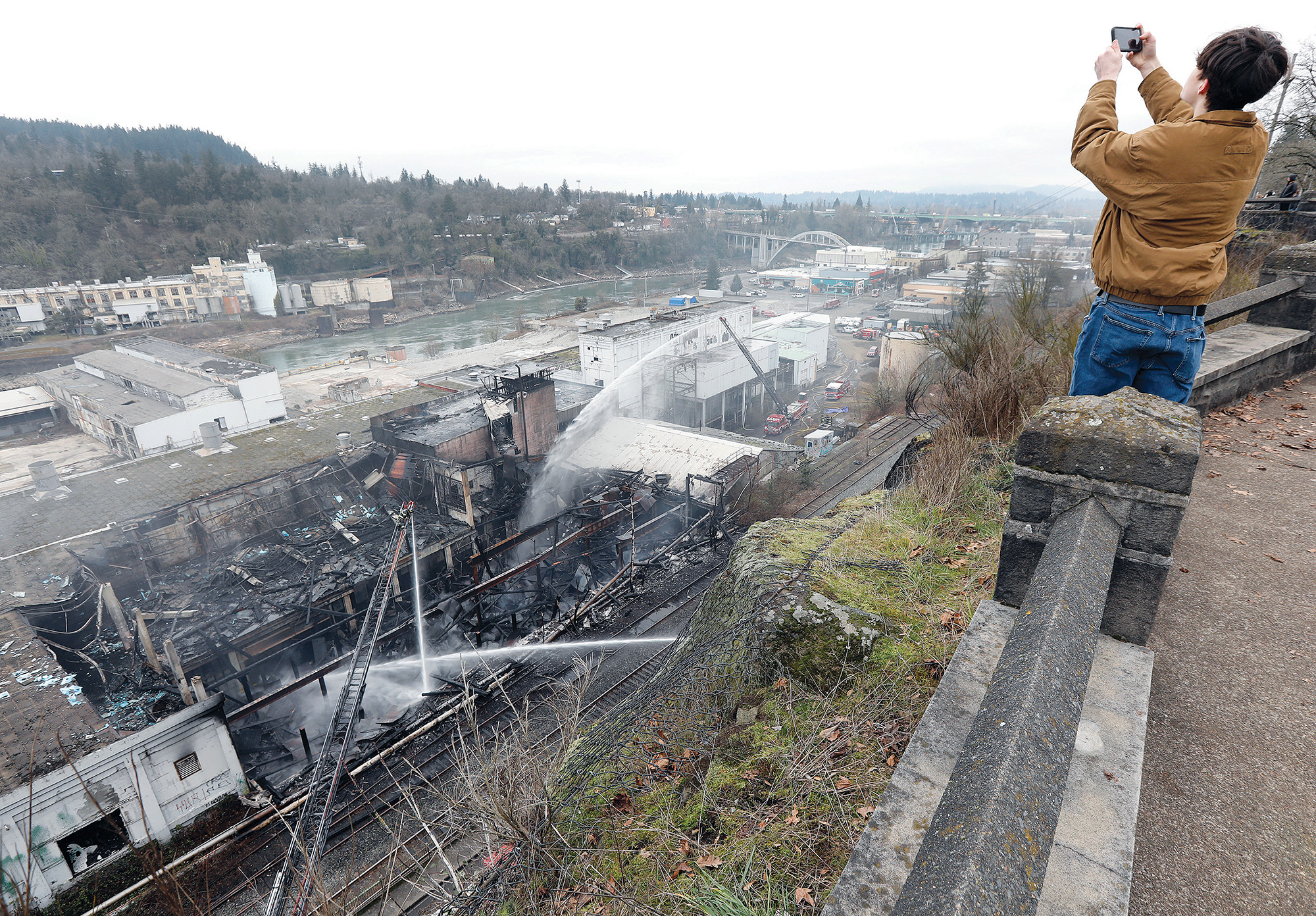Tribal Government & News
Fire at tumwata village site continues to smolder

By Nicole Montesano
Smoke Signals staff writer
OREGON CITY -- A fire at the former Blue Heron Paper Mill, the Tribe’s tumwata village property, continues to smolder because it is too dangerous to enter the building and the roof is blocking water from reaching it, Clackamas Fire District officials said in a meeting on Friday, Feb. 7.
The community meeting, which included public officials and Tribal Engineering and Planning Manager Ryan Webb, was intended to update the public about the fire. No cause has been released yet, as the fire is still under investigation. It began in the early morning hours of Thursday, Jan. 30.
“The fire is completely contained,” Assistant Fire Chief Dan Mulick said. “There is still smoke and flames that continue to pop up but that, again, is happening because we are doing a constant risk assessment and we are not going to put our firefighters at risk for something of no value.”
Even without entering, he said, firefighters attacking the fire from the bluff above the plant suffered burns and equipment was damaged by the heat of the fire.
Webb said the Tribe is working to demolish the buildings as quickly as possible.
He was notified of the fire within 15 minutes of the call to the fire district and reported to the site immediately. Later in the morning, Mulick asked him to join the fire district’s incident command team to oversee firefighting efforts, coordinate with officials from across the state, and help where possible. That included hiring a contractor to conduct air quality monitoring and bringing in heavy equipment.
“We got a contractor out there to continue to do monitoring on a daily basis,” he said. “Really, the focus is on asbestos fibers, but they also do air quality monitoring related to gases as well.”
So far, no dangers have been found.
The Tribe has been working to clean up the property since purchasing it in 2019.
“The Tribe is very well-versed in demolition activities on the site, as well as cleanup activities,” Webb said. “Demolition has a process to follow … from permits to doing sampling of the materials, to putting a plan in place, to then mobilizing specialized equipment to do it. We are all moving forward, and I think there’s been a lot of great collaboration from all entities involved to make sure that this happens in a timely manner, but there still is a process too, that we have to follow to make that happen.”
Nonetheless, Webb said, “I can assure everybody that the Tribe is doing what we can in a very timely manner to get these structures down as quickly as possible.”
Before the fire, the Tribe had planned on conducting demolition this year but that the timetable has been moved up.
Both Clackamas fire officials and Webb noted that the site is hard to keep trespassers out of, even with 24-hour onsite security, because the buildings are enormous and interconnected.
“The site itself is just such a maze of buildings that it is very difficult to know if someone is even on the site. … our best and quick way to secure it is probably really taking structures down,” he said.
The mill has long been a fire hazard.
“Clackamas Fire is very familiar with the Blue Heron complex,” Mulick said. “We have had numerous fires while the mill was operating that were smaller in nature, but it brought us in there quite often to get an understanding of that campus. Once the mill was shut down, we were very fortunate to have access to that property for training and it really has brought a greater awareness of the complexity, once we began actually hosting drills. … Under any static situation that is a dangerous building, a dangerous complex, with pitfalls and falling debris and sharp objects.”
The dangers were forcibly brought home to the district, Mulick said, during a fire in 2020.
“We made tactical, strategic decisions to put our firefighters at risk, to mitigate the life threat that was brought forward to us,” he said.
However, the roof collapsed while firefighters were inside the building, with another crew on the roof. Both groups barely escaped.
“That was a significant near miss with our agency and it drastically changed the way we handled this incident on January 30,” Mulick said. “There is no imminent risk to lives or properties or structures surrounding the Blue Heron incident and we will take no risk on a structure that has no value. We will continue to monitor it. We have crews that are passing by constantly and looking at the view from above, on the promenade, and we are going to manage anything that comes up, with reasonable expectations focused around firefighter safety.”
Webb said he is grateful to the district.
“(Firefighters) did an incredible job working to get that fire out and make sure it was safe for the public, and we at the Tribe are deeply grateful,” he said. “You truly are some amazing people doing some amazing work.”
